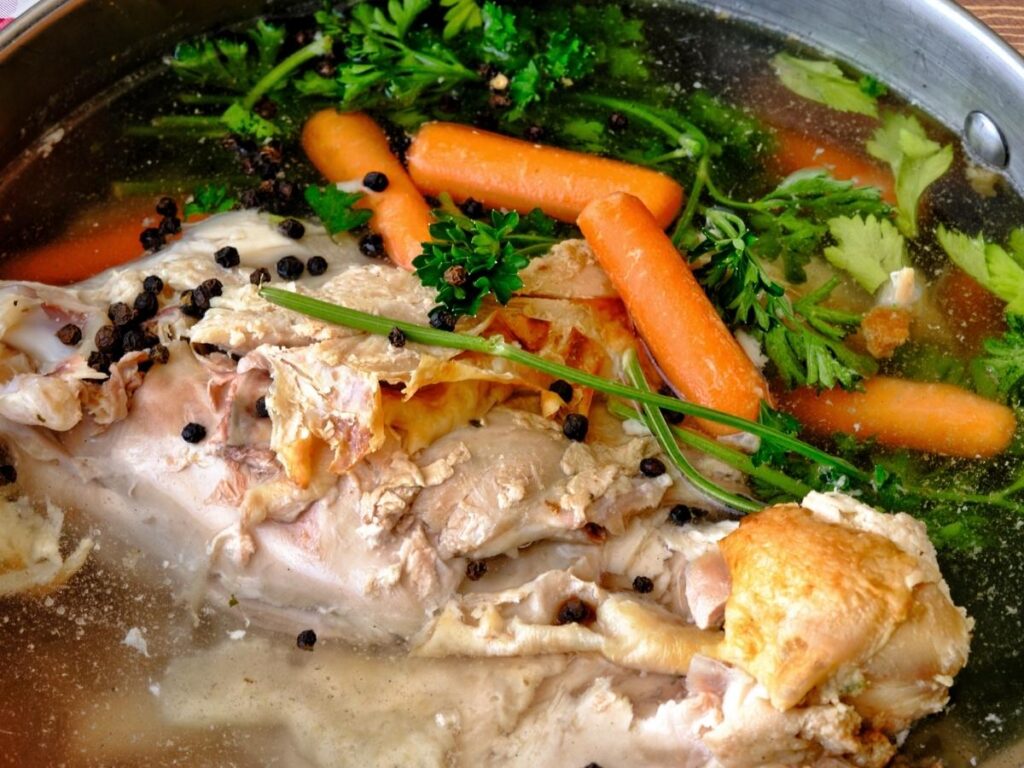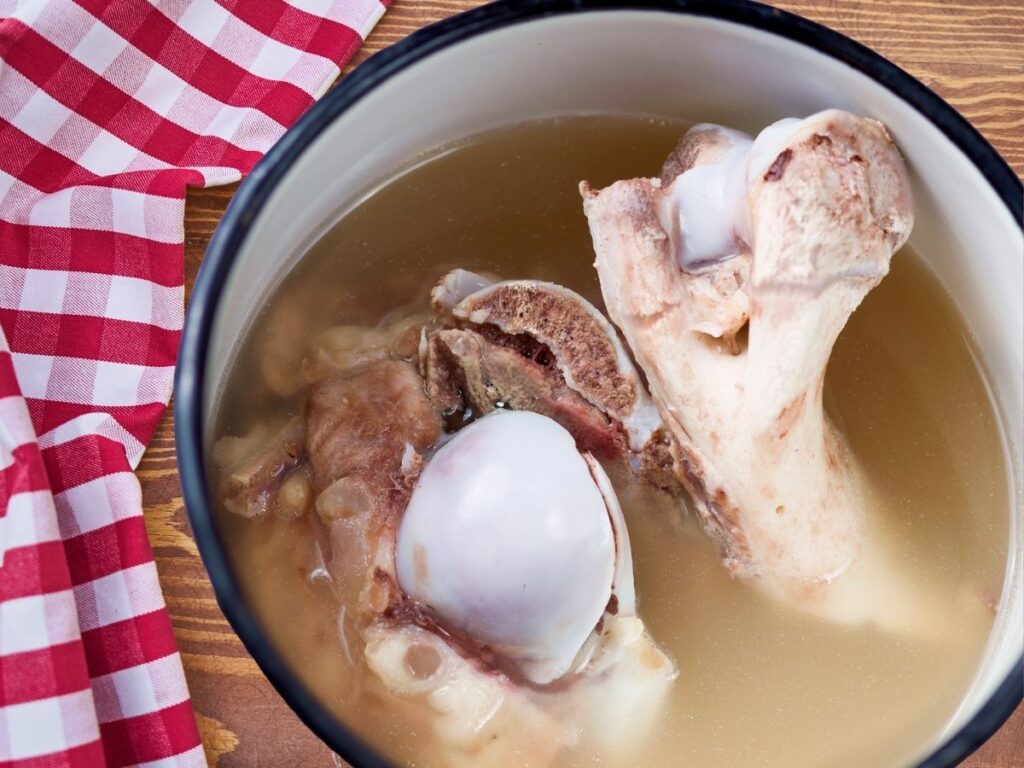In the world of cooking, certain terms get used so often that we assume they mean the same thing. Walk down any soup aisle, and you’ll see cartons labeled chicken stock, chicken broth, and bone broth. While they all start with similar ingredients, the battle of chicken stock vs bone broth reveals key differences in cooking time, nutrition, and taste.
So, what sets them apart? This guide will break down everything you need to know. We’ll explore how each is made, compare their nutritional profiles, and help you decide which one is right for your kitchen adventures.
How They’re Made:
The primary difference between stock and bone broth lies in the ingredients and, most importantly, the simmer time.
Making Chicken Stock
Chicken stock is a cooking liquid made by simmering chicken bones (often with some meat still on them) with vegetables like onions, carrots, and celery (a combination known as mirepoix). The goal is to extract the rich chicken flavor and gelatin from the bones.
- Ingredients: Primarily chicken bones (like leftover roasted chicken carcasses), a small amount of meat, and aromatic vegetables.
- Simmer Time: Typically simmers for 4 to 6 hours. This is long enough to pull flavor and some collagen from the bones but not as long as bone broth.
- Result: A light-colored liquid with a clean, savory chicken flavor. When chilled, good stock will have a slightly gelatinous texture.
Making Bone Broth
Bone broth takes the process a step further. It is specifically designed to extract the maximum amount of nutrients, minerals, and collagen from the bones.
- Ingredients: A high ratio of bones to meat is used, often from joints rich in cartilage like knuckles, feet, and marrow bones. A splash of apple cider vinegar is usually added to help break down the bones and release more nutrients.
- Simmer Time: This is the biggest differentiator. Bone broth simmers for a very long time anywhere from 12 to 48 hours.
- Result: A deeper, richer liquid that is often thicker than stock. When chilled, it should be very firm and jelly-like, which is a clear sign of its high collagen content.
Chicken Stock vs Bone Broth Nutrition Value
When deciding which is healthier, Chicken Stock vs Bone Broth , the longer cooking time of bone broth gives it a distinct nutritional advantage.
| Nutrient | Chicken Stock | Bone Broth |
|---|---|---|
| Calories | Lower in calories, often around 10-30 per cup. | Slightly higher, ranging from 40-100 per cup. |
| Protein | Contains some protein, typically 1-5 grams per cup. | Significantly higher in protein, with 10-20 grams per cup. |
| Collagen | Contains a small amount of collagen, giving it a slight gel. | Packed with collagen, which breaks down into gelatin during cooking. |
| Minerals | Provides some minerals like calcium and potassium. | Rich in minerals like calcium, magnesium, phosphorus, and glucosamine. |
The main takeaway from the Chicken Stock vs Bone Broth protein comparison is that bone broth is the clear winner. Its extended simmer time extracts more of the collagen, which is a protein, and other beneficial compounds from the bones and connective tissues. This makes it a nutritional powerhouse compared to its quicker-cooking cousin.
Taste, Usage, and Storage
While they come from a similar place, their distinct profiles make them suitable for different culinary purposes.
Chicken Stock vs Bone Broth Taste
Chicken stock has a lighter, more neutral chicken flavor. It is designed to be a base that supports other ingredients in a dish without overpowering them.
Bone broth, on the other hand, has a much deeper, richer, and more savory flavor. You can taste the intensity that comes from the long simmer time. It’s robust enough to be enjoyed on its own as a warm, comforting drink.
Chicken Stock vs Bone Broth Common Uses
So, when should you use stock vs bone broth for soup or other dishes?
Use Chicken Stock for:
- Soups and Stews: It provides a perfect flavor foundation for classics like chicken noodle soup or a hearty beef broth vs stock for stew.
- Sauces and Gravies: Its mild flavor won’t compete with the other ingredients.
- Cooking Grains: Use it instead of water to add flavor to rice, black beans, quinoa, or risotto.
Use Bone Broth for:
- Sipping: Many people drink a warm cup of bone broth daily for its nutritional benefits.
- Flavor-Forward Soups: Use it when you want the broth to be the star, like in a simple noodle soup or ramen.
- For Babies and Toddlers: When considering meat stock vs bone broth for baby, both can be great. However, the gut-healing properties and high mineral content of bone broth make it a popular choice for introducing savory flavors. Always serve unsalted versions to little ones.
Storage and Shelf Life
Both stock and bone broth can be stored the same way.
- Refrigerator: Store in an airtight container for up to 5 days.
- Freezer: For longer storage, freeze it. Pour into ice cube trays for small, convenient portions, or store in freezer-safe bags or containers for up to 6 months.
Serving and Temperature Guide
Both chicken stock and bone broth should be heated to a gentle simmer before being used in recipes or consumed. For sipping, heat your bone broth until it’s pleasantly hot, like a cup of tea or coffee, but not boiling. A temperature around 150-170°F (65-77°C) is ideal.
The Classic Chicken Stock Recipe

This recipe is your go-to for a light, flavorful liquid that enhances any dish without overpowering it. It’s the perfect way to use up leftover chicken carcasses and vegetable scraps.
Recipe Overview
| Prep Time | 15 min |
| Cook Time | 4-6 hours |
| Yield | About 12-16 cups (3-4 quarts) |
| Difficulty Level | very easy |
Best for: Soups, sauces, gravies, and cooking grains.
Ingredients
- 1 large (or 2 small) leftover roasted chicken carcasses, about 3-4 lbs, meat picked off
- 2 large yellow onions, unpeeled and quartered
- 4 large carrots, scrubbed and roughly chopped (no need to peel)
- 4 celery stalks, roughly chopped
- 1 head of garlic, sliced in half horizontally
- 1 bunch fresh parsley stems
- 10 whole black peppercorns
- 2 bay leaves
- 16-20 cups of cold, filtered water (or enough to cover ingredients by 2 inches)
Step-by-Step Procedure: How to Make Chicken Stock
- Combine Ingredients: Place the chicken carcass, onions, carrots, celery, garlic, parsley stems, peppercorns, and bay leaves into a large stockpot (at least 8 quarts).
- Add Cold Water: Pour in enough cold water to cover all the ingredients by at least two inches. Using cold water helps to draw out the collagen and proteins more slowly, resulting in a clearer stock.
- Bring to a Simmer: Place the pot on the stove over medium-high heat. Bring the liquid to a gentle simmer, but do not let it come to a rolling boil. Boiling can make the stock cloudy and break down the delicate flavors.
- Skim the Scum: As the water heats up, a layer of foam or “scum” will rise to the surface. Use a large spoon or skimmer to carefully remove and discard this layer. This is crucial for achieving a clean-tasting and clear stock.
- Simmer Gently: Once you’ve skimmed the surface, reduce the heat to low. The stock should maintain a very gentle simmer, with just a few bubbles breaking the surface. Cover the pot partially, leaving a small gap for steam to escape.
- Let it Cook: Let the stock simmer for at least 4 hours, but up to 6 hours. The longer it simmers, the more flavor will be extracted from the ingredients.
- Strain the Stock: After simmering, turn off the heat and let the stock cool slightly. Place a fine-mesh sieve or a colander lined with cheesecloth over a large, heatproof bowl. Carefully ladle or pour the stock through the strainer to remove all the solids. Discard the bones and vegetables.
- Cool and Store: Let the strained stock cool to room temperature before refrigerating. For faster cooling, you can place the bowl of stock in an ice bath. Once chilled in the refrigerator, a layer of fat will solidify on top. You can scrape this off and discard it (or save it for cooking). The stock can be stored in an airtight container in the refrigerator for up to 5 days or frozen for up to 6 months.
Serving and Nutritional Value
Serving Suggestions: Use your homemade chicken stock as a base for chicken noodle soup, to make a flavorful risotto, or to create a velvety pan sauce for roasted meats.
Nutritional Value of Chicken Stock (per 1 cup serving, approximate):
- Calories: 15-30 kcal
- Protein: 1-3 g
- Fat: 0.5-1 g
- Carbohydrates: 1-2 g
- Sodium: 50-100 mg (if unsalted)
- Collagen: Contains a small amount, which may cause it to gel slightly when chilled.
The Nutrient Dense Bone Broth Recipe

This is more than just a cooking liquid; it’s a nutritional powerhouse. The extended cooking time for this bone broth recipe is designed to pull the maximum amount of collagen, gelatin, and minerals from the bones.
Recipe Overview
| Prep Time | 20 min |
| Cook Time | 12-24 hours (or more) |
| Yield | About 12-16 cups (3-4 quarts) |
| Difficulty Level | very easy |
Best for: Sipping as a warm beverage, fortifying soups, or for anyone looking for a gut-healing, protein-rich drink.
Ingredients
- 4-5 lbs chicken bones (a mix of backs, necks, wings, and feet is ideal for high collagen)
- 2 tablespoons apple cider vinegar
- 2 large yellow onions, unpeeled and quartered
- 4 large carrots, scrubbed and roughly chopped
- 4 celery stalks, roughly chopped
- 1 head of garlic, sliced in half horizontally
- 1 bunch fresh parsley
- 1 tablespoon whole black peppercorns
- 16-20 cups of cold, filtered water
Step-by-Step Procedure: How to Make Bone Broth
- Roast the Bones (Optional but Recommended): For a deeper, richer flavor, spread the chicken bones on a baking sheet and roast them in a preheated oven at 400°F (200°C) for 20-30 minutes, or until they are browned.
- Combine and Soak: Place the roasted (or raw) bones in a large stockpot or slow cooker. Add the apple cider vinegar and enough cold water to cover the bones completely. Let them sit for 30-60 minutes. The vinegar helps begin the process of breaking down the cartilage and drawing minerals from the bones.
- Add Vegetables and Aromatics: Add the onions, carrots, celery, garlic, and peppercorns to the pot. Top with more cold water to ensure everything is covered by about two inches.
- Bring to a Simmer: Place the pot on the stove over medium-high heat and bring to a gentle simmer. Just like with stock, avoid a rolling boil. Skim off any foam or impurities that rise to the top.
- Simmer Long and Slow: Reduce the heat to the lowest possible setting. The goal is a barely-there simmer. Let it cook for a minimum of 12 hours, but ideally for 24 hours. If using a slow cooker, set it to “low” and let it go for 24-48 hours.
- Add Fresh Herbs: During the last 30 minutes of cooking, add the bunch of fresh parsley. This adds fresh flavor without the bitterness that can come from cooking herbs for too long.
- Strain the Broth: Turn off the heat and allow the broth to cool slightly. Strain it through a fine-mesh sieve into a large bowl, discarding the solids. The bones should be soft and may even crumble, which is a sign you’ve extracted their nutrients.
- Cool and Store: Cool the broth to room temperature before moving it to the refrigerator. Once fully chilled, a thick layer of fat will form on top. Remove and discard this. The broth underneath should be very gelatinous and firm, like jelly. This is the sign of a perfect, collagen-rich bone broth! It can be stored in the fridge for up to a week or frozen for 6+ months.
Serving and Nutritional Value
Serving Suggestions: Heat a mug of bone broth and sip it plain, seasoned with a pinch of salt and pepper. You can also use it as a supercharged base for any soup or stew.
Nutritional Value of Bone Broth (per 1 cup serving, approximate):
- Calories: 40-100 kcal
- Protein: 10-15 g
- Fat: 1-3 g
- Carbohydrates: 1-3 g
- Sodium: 100-200 mg (if unsalted)
- Collagen: Very high. Rich in amino acids like glycine and proline, as well as minerals like calcium, magnesium, and phosphorus.
Frequently Asked Questions (FAQs)
Chicken Stock vs Bone Broth:Which is better?
“Better” depends on your goal. For a neutral cooking base, stock is excellent. For maximum nutrition and a rich flavor you can sip, bone broth is the winner.
Which broth is the healthiest?
Generally, bone broth is considered the healthiest due to its higher concentration of protein, collagen, and minerals extracted during the long cooking process.
Does chicken stock have collagen?
Yes, chicken stock does contain some collagen, which is why it may gel slightly when chilled. However, bone broth has a much higher concentration.
Can bone broth be a substitute for stock?
Absolutely! Can bone broth be a substitute for stock? Yes, you can use bone broth in any recipe that calls for stock. Just be aware that its flavor is much richer and more pronounced, which could alter the final taste of your dish.
Conclusion: Which One Should You Choose?
The debate of chicken stock vs bone broth doesn’t have a single winner it has the right choice for the right situation.
- Choose chicken stock when you need a versatile, light-flavored base for soups, sauces, and general cooking. It’s a foundational ingredient that enhances dishes without taking over.
- Choose bone broth when you want a nutritional powerhouse with a deep, savory flavor. It’s perfect for sipping on its own, fortifying soups, or adding a rich dose of protein and collagen to your diet.
Both are valuable additions to any kitchen. Understanding their unique qualities allows you to unlock more flavor and nutrition in your everyday cooking. Whether you’re simmering a pot for six hours or two days, you’re creating a liquid gold that will elevate your meals from good to great.







